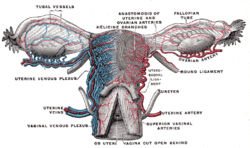Arcuate vessels of uterus
| Arcuate vessels of uterus | |
|---|---|
 Vessels of the uterus and its appendages, rear view. Helicine branches (an older name for arcuate vessels) are labeled at center top - they appear to course on the surface of the uterus in this picture, but in fact they course within the myometrium. | |
 Uterine arterial vasculature, showing arcuate arteries at left.[1] | |
| Details | |
| Source | Uterine artery |
| Identifiers | |
| Latin | Rami helicini uterinae |
| TA | A12.2.15.030F |
| FMA | 75579 |
The arcuate vessels of the uterus are a component of the blood supply of the uterus. They are arteries and veins that branch from the uterine arteries and veins, respectively, with additional anastomoses from the ovarian arteries and veins,[2] and penetrate and assume a circumferential course in the myometrium.[3]
They have also been called helicine branches of the uterus (or helicine arterioles), as they are spiral-shaped, but they should not be confused with the spiral arteries that penetrate the endometrium in the inner uterus.
References
- ↑ Robertson, W. B. (1976). "Uteroplacental vasculature". Journal of Clinical Pathology. 29: 9. doi:10.1136/jcp.29.Suppl_10.9.
- ↑ Bottom of page 123 in: Hurd, William W.; Falcone, Tommaso (2007). Clinical reproductive medicine and surgery. St. Louis, Mo: Mosby/Elsevier. ISBN 0-323-03309-1.
- ↑ Page 440 - section Uterus in: Fiore, Mariano S H di; Eroschenko, Victor P. (2008). Di Fiore's Atlas of histology: with functional correlations. Philadelphia: Wolters Kluwer Health/Lippincott Williams & Wilkins. ISBN 0-7817-7057-2.
This article is issued from Wikipedia - version of the 11/10/2016. The text is available under the Creative Commons Attribution/Share Alike but additional terms may apply for the media files.